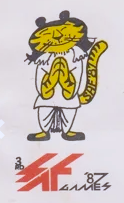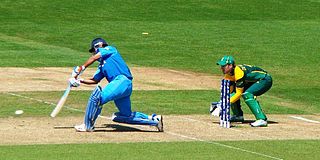Related Research Articles

Kabaddi is a contact team sport played between two teams of seven players, originating in ancient India. The objective of the game is for a single player on offense, referred to as a "raider", to run into the opposing team's half of the court, touch out as many of their players as possible, and return to their own half of the court, all without being tackled by the defenders in 30 seconds. Points are scored for each player tagged by the raider, while the opposing team earns a point for stopping the raider. Players are taken out of the game if they are touched or tackled, but return to the game after each point scored by their team from a tag or tackle.

The 1936 Summer Olympics, officially the Games of the XI Olympiad and officially branded as Berlin 1936, was an international multi-sport event held from 1 to 16 August 1936 in Berlin, Germany. Berlin won the bid to host the Games over Barcelona on the 29th IOC Session on 26 April 1931. The 1936 Games marked the second and most recent time the International Olympic Committee gathered to vote in a city bidding to host those Games. Later rule modifications forbade cities hosting the bid vote from being awarded the games.

In many team sports, defense or defence is the action of preventing an opponent from scoring. The term may also refer to the tactics involved in defense, or a sub-team whose primary responsibility is defense. Similarly, a defense player or defender is a player who is generally charged with preventing the other team's forwards from being able to bear down directly on their own team's goalkeeper or goaltender. Such positions exist in association football, ice hockey, water polo and many other sports.
A demonstration sport, or exhibition sport, is a sport which is played to promote it, rather than as part of standard medal competition. This occurs commonly during the Olympic Games but may also occur at other sporting events.

Kho kho is a traditional South Asian sport that dates to ancient India. It is the second-most popular traditional tag game in the Indian subcontinent after kabaddi. Kho kho is played on a rectangular court with a central lane connecting two poles which are at either end of the court. During the game, nine players from the chasing team are on the field, with eight of them sitting (crouched) in the central lane, while three runners from the defending team run around the court and try to avoid being touched. Each sitting player on the chasing team faces the opposite half of the field that their adjacent teammates are facing.

The Padmavyūha or Chakravyūha is a military formation used to surround enemies, depicted in the Hindu epic Mahabharata. It resembles a labyrinth of multiple defensive walls.

The 1987 South Asian Games, officially the 3rd South Asian Federation Games were a multi-sport event, held in Kolkata, India from 20 November to 27 November 1987. It was the largest sporting event ever to be held in Kolkata, and West Bengal as a whole. This was also the first time India hosted these Games.

Mallakhamba, or mallakhamb is a traditional sport, originating from the Indian subcontinent, in which a group of gymnasts perform aerial yoga and gymnastic postures using wrestling grips in concert with a stationary vertical pole. The word "mallakhamb" also refers to the pole used in the sport. The pole is usually made from sheesham polished with castor oil. Other popular versions of mallakhamba are practiced using a cane or a rope instead of a pole. The origins of pole dancing can be traced back to the sport of mallakhamba.

Association football and basketball are the most popular sports in Asia. Cricket is the third most popular sport in Asia, and is most popular in South Asia. Other popular sports in Asia include baseball, badminton and table tennis among others. There are also some traditional sports that are popular in certain regions of Asia, such as the South Asian sports kabaddi and kho-kho, and sepak takraw in Southeast Asia. Top sporting nations/regions in Asia include China, Japan, South Korea, Taiwan, India, Iran, Kazakhstan and Uzbekistan.

India has a history of sports dating back to the Vedic period, with Western sports having been imported during British rule. Cricket is the most popular spectator sport; it generates the highest television viewership, with the Indian Premier League (IPL) being the most-followed league in the country. Football has also gained popularity, with the Indian Super League (ISL) being the highest level of domestic football, and the national team winning multiple gold medals at the Asian and South Asian Games. Additional football accomplishments include India having reached the Groupstage of the 1960 Olympics, qualified for the 1950 FIFA World Cup, and won the SAFF Championship. Other sports include kabaddi, badminton, tennis, and athletics, with kho-kho becoming the fourth-most viewed sport. India has also had success in field hockey, winning the World Cup and multiple medals in the Olympic Games. Sports such as golf, rugby, boxing, kickboxing, mixed martial arts, motorsport, wrestling, and basketball are featured throughout the country.
Kabaddi, is a contact sport, native to the Indian subcontinent. It is one of the most popular sports in India, played mainly among village people. India has taken part in four Asian Games in kabaddi, and won gold in all.

The India women's national kabaddi team represents India in international women's kabaddi competitions.
Sports play an integral part of culture in the Indian state of Maharashtra. Cricket is the most popular spectator sport in the state. Other popular sports include kabaddi and kho kho, which are played in rural areas, and field hockey, badminton, and table tennis, which are more common in urban areas, schools, and colleges. In the state's southern rural regions, annual wrestling championships such as Hind Kesari and Maharashtra Kesari are held. Games like Viti-Dandu and variations of Tag are played among children.
Popularly known as HVPM, this is a premier institute in India for physical training. It was set up by Mr Anant Vaidya and Mr Ambadas Vaidya around 1914. Earlier it was referred as Hanuman Akhada. Many political leaders and freedom fighters have visited HVPM. It is said that Shivaram Rajguru studied at HVPM. During his hideout Chandrashekhar Azad also stayed here for few days. The HVPM demonstrated traditional Indian sports at the 1936 Olympics. The institution also has an engineering college in its campus run under the same management committee.

Khelo India Youth Games are the annual national level multidisciplinary grassroot games in India held in January or February for two categories, namely under-17 years school students and under-21 college students. Every year best 1,000 kids will be given an annual scholarship of ₹5 lakh (US$6,000) for 8 years to prepare them for the international sporting events.

India has several traditional games and sports, some of which have been played for thousands of years. Their popularity has greatly declined in the modern era, with Western sports having overtaken them during the British Raj, and the Indian government now making some efforts to revive them. Many of these games do not require much equipment or playing space. Some of them are only played in certain regions of India, or may be known by different names and played under different rules and regulations in different regions of the country. Many Indian games are also similar to other traditional South Asian games.

South Asia has many traditional games and sports. Two of them, kabaddi and kho-kho, are played at the South Asian Games, with kabaddi also featuring at the Asian Games. Many of these games are played across the entire subcontinent under different names and with some rule variations, while some of these games may be played only in certain countries or regions.

Many sports are played in South Asia, with cricket being the most popular of them; 90% of the sport's worldwide fans live in South Asia. Football is followed passionately in some parts of South Asia, such as Kerala and Bengal. Field hockey was popular for several decades, with some of South Asia's greatest sporting accomplishments having taken place in this sport. Some native South Asian games are played professionally in the region, such as kabaddi and kho-kho, and also feature in regional competitions such as the South Asian Games and Asian Games.
Vijayveer Sidhu is an Indian sport shooter from Punjab. He won the bronze medal in Men's 25m rapid fire pistol team in the 2022 Asian Games. He bagged an Olympic quota berth for the Paris Olympics in the 25m rapid fire by winning a silver medal at the Asian Olympic Qualifiers on 13 January 2024 at Jakarta. However, he could not make to the final team after selections. His twin brother Udhayveer Sidhu also is a successful sports shooter.
The 56th National Kho Kho Championship took place from 27 March to 1 April 2024 in New Delhi, India. The National championship is the top tournament in India, annually contested by the states, and the winner is declared as the National champion. Maharashtra won both the men's and women's titles in the 56th edition.
References
- 1 2 3 Nag, Utathya (2021-04-21). "Was kabaddi in Olympics? Here's the truth". Olympics.com. Retrieved 2024-01-28.
- ↑ Nag, Utathya (2022-04-14). "Kho Kho: History, rules and how to play". Olympics.com. Retrieved 2024-01-28.
- ↑ "When a kabaddi team from India left Hitler, Mahatma in awe at 1936 Olympics". Business Standard. 2018-12-02. Retrieved 2024-01-28.
- 1 2 Kamath, Amit (2016-10-26). "The forgotten story of kabaddi's tryst with Hitler, the Olympics". Hindustan Times. Retrieved 2024-01-28.
- ↑ Ramachandran, Aishwarya (2019). Counterflows of knowledge : the transnational circulation of physical culture practices between India and the West during the early 20th century (Thesis). University of British Columbia. p. 32.
- ↑ "Demonstration sports : history at the Olympic Summer Games / The Olympic Studies Centre". Olympic World Library. 2024-01-19. Archived from the original on 2024-01-19. Retrieved 2024-01-27.
- ↑ "85 years after Berlin Olympics, 'Hitler Medal' occupies pride of place at Maha sports institute". The Economic Times. 2021-07-24. Retrieved 2024-01-28.
- ↑ Ayyar, Kamakshi (2015-04-02). "The Dizzying, Acrobatic Sport of Yoga on a Pole". VICE. Retrieved 2024-01-28.